The Microsoft Surface Book 2 (15-Inch) Review: Second Time's The Charm
by Brett Howse on December 21, 2017 8:00 AM EST- Posted in
- Laptops
- Microsoft
- Surface
- Pascal
- Surface Book
- Kaby Lake Refresh
CPU Performance
Microsoft offers the smaller 13.5-inch model with a Core i5-7300U on the base model, but once you add a GPU you get the Core i7-8650U. The 15-inch model comes exclusively with the Core i7 model. This is Kaby Lake Refresh, and the refresh is that Intel doubled the physical number of cores in the CPU, going from two to four. The Core i7 models keep Hyperthreading as well, meaning you get eight threads available. Prior to this fall, the only way to get this many cores was to go with the HQ series of processors, which have a 45-Watt TDP. That would be a bit much for a laptop with a detachable tablet, so the 15-Watt Core i7-8650U is a great way to add more multithreaded performance without increasing the heat output.
Microsoft has also included the same power management software as the Surface Pro, meaning you can choose your power setting as Best Performance, Better Performance, or Best Battery Life, with the latter being the system default. This adjusts the CPU efficiency by tweaking the PL1 and PL2 levels to lower and higher results, depending on the slider setting. When in the default state, the advantage is that the system fans almost never need to be used, meaning the system is nice and quiet, but if you’re doing something that’s processor intensive, turning it up will improve the performance, with the trade-off being noise. As you’d expect, the benchmarks were run in the Best Performance mode, and battery life testing was done in Best Battery Life.
Unlike the Surface Pro, there’s no Iris GPU available, although that’s not a surprise thanks to the much more powerful GPU available in the base, and the fact that Iris isn’t offered yet in the 8th generation products.
To test CPU performance, the Surface Book 2 was run through our standard suite of laptop tests, and compared to several similar models. If you want to compare the Surface Book 2 against any device we’ve tested, please see our Notebook Bench.
PCMark
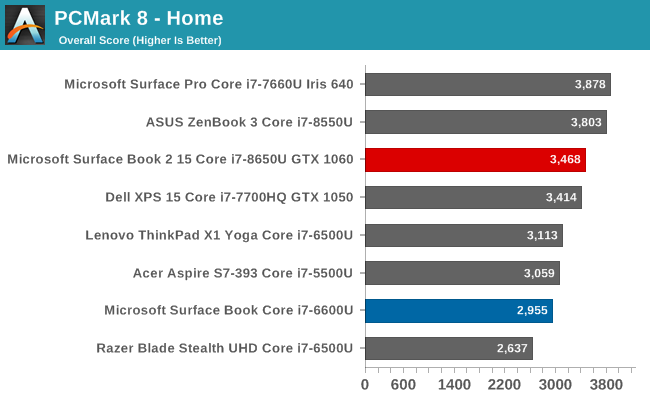
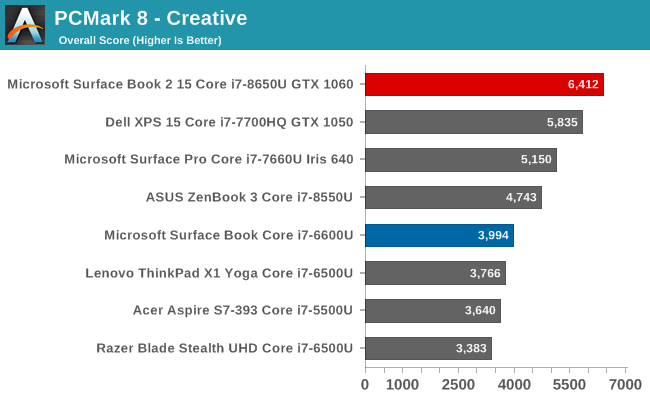
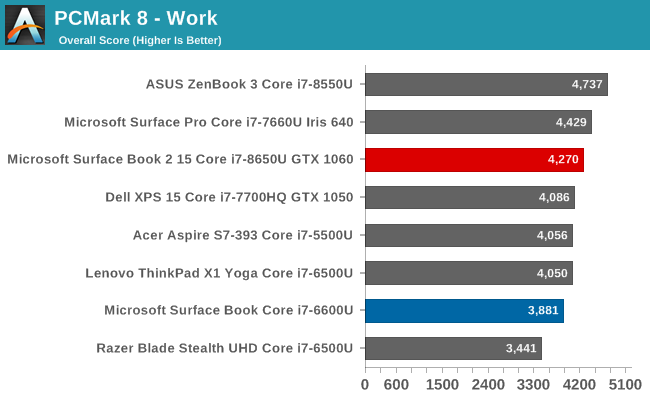
PCMark tests an entire system, from the CPU to the GPU to the storage, and all aspects of the device, including things like the display resolution, impact the results. The Surface Book 2 performs well on all of the tests, and it’s unsurprising to see it at the top for Creative, which has several GPU focused tests.
Cinebench
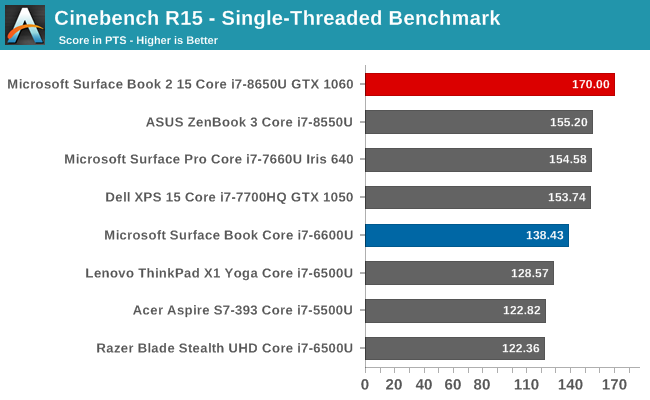
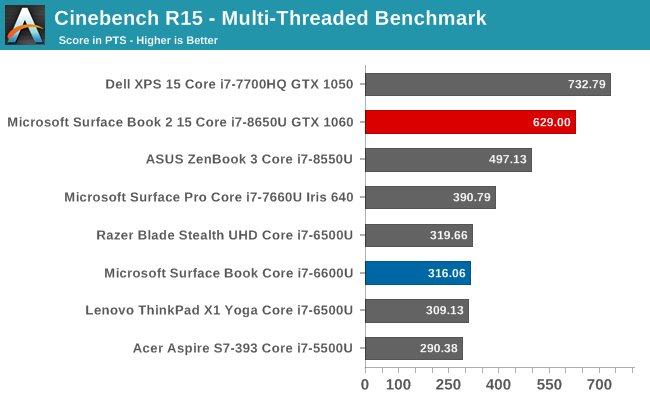
Cinebench is a rendering test which can use OpenCL, a single CPU thread, or all CPU threads to render the image. Our test focuses on the two CPU tests, and it gives us a great look at per-thread performance, and how that scales with more cores. Here the high turbo frequency of the Core i7-8650U delivers excellent single-threaded performance, and the multi-core result is also very strong. It can’t quite hang with XPS 15, but that has a 45-Watt TDP on its eight threads, allowing them to maintain a much higher turbo for the multithreaded result.
x264


Much like Cinebench, the x264 test converts a video using the CPU, and more cores with higher frequency generally wins the day here. The Surface Book 2 outperforms all other laptops with the 15-Watt TDP U series CPU in this test, but the higher TDP XPS 15 can still outperform it significantly when all cores are utilized.
Web Tests
The web is one of the most-used tools around, but performance on the web can be tied to the CPU as well as the browser itself. Over time, scripting performance in the browser continues to improve, and which browser you use will also impact performance and battery life. To make everything consistent, we utilize Microsoft Edge for all testing on Windows.
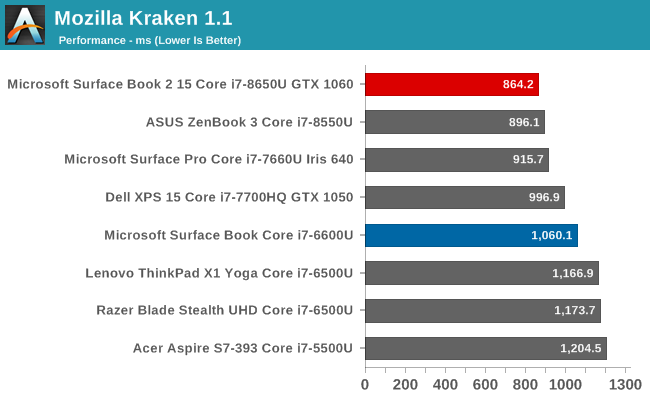
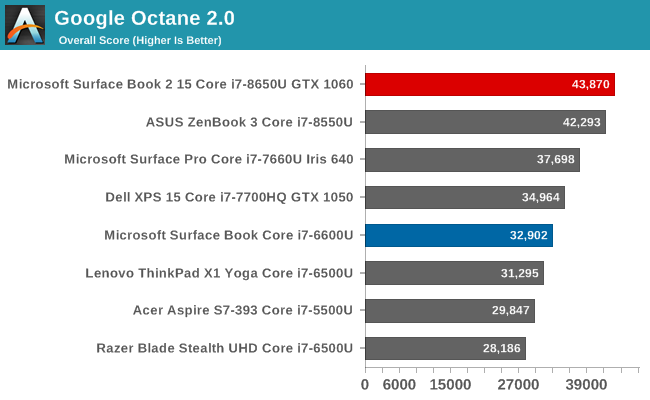
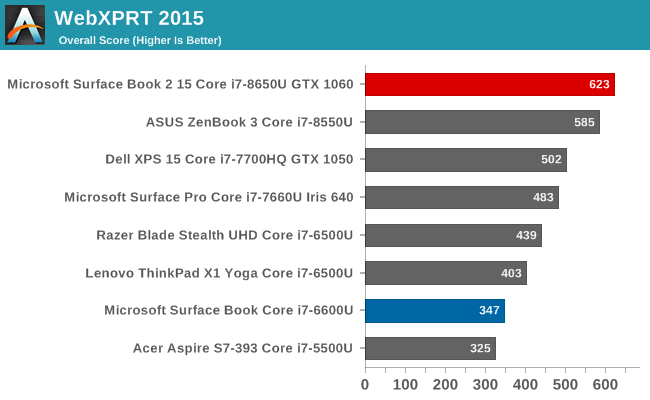
The Surface Book 2 has a slight CPU advantage over the ASUS ZenBook 3, and with that edge it creeps ahead in all of the web tests. The extra cores, as well as the updates to the browser with the Fall Creators Update, have made a significant difference over the older results. It would be nice to go back on some of these older devices to see how much of an impact the browser updates have made, if we still had the devices.
CPU Conclusion
As we saw with the ASUS ZenBook 3, the move to quad-core in the U series of Core chips has been very welcome. The performance increase is impressive over the older dual-core models, and although the eight threads run into the thermal limit quicker than the do on the higher-wattage HQ series chips, such as seen in the Dell XPS 15, the Core i7-8650U is still a very strong performer.
Storage Performance
The review unit for the Surface Book 2 shipped with the maximum drive size available, which is the 1 TB model. Thanks to the parallel nature of SSDs, this model should offer the best performance. The drive in the unit is a Samsumg PM961, which is a TLC based drive.
Performance is excellent for a TLC drive, and we do see the sequential write being affected by the TLC NAND, but all other aspects of the performance are excellent. In a device hitting this price target, a MLC version of this drive would be preferable, but it’s unlikely most people will notice the limits of this drive because it is quite good.


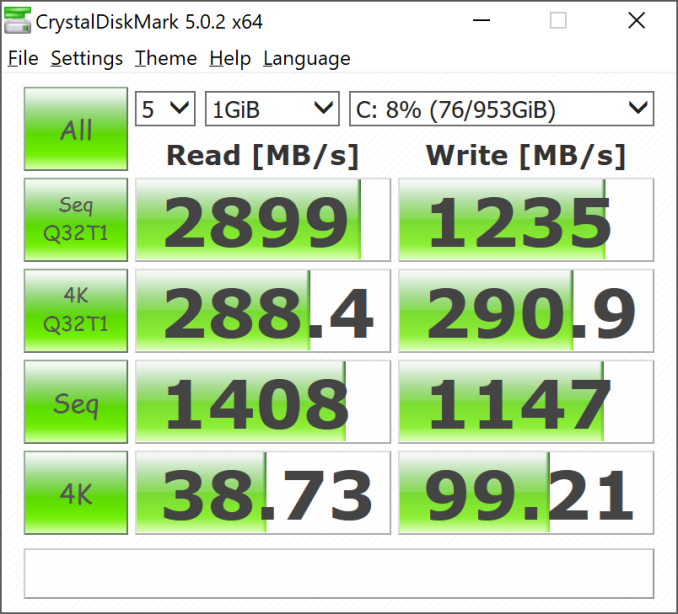








120 Comments
View All Comments
damianrobertjones - Friday, December 22, 2017 - link
Yes... because a 120hz HDR display is essential. Marketing OWNS your soul.The review already states that the screen is, more or less, amazing so adding those two extra features doesn't really do much.
P.s. The iPad Pro, albeit nice, isn't really on the same league (imo).
Frenetic Pony - Friday, December 22, 2017 - link
I have a 120hz desktop screen and is awesome. And I've been waiting on a proper her screen for photo and video editing. Being snide and ignorant gets you nowhere.zogus - Tuesday, December 26, 2017 - link
The iPad Pro's 120Hz display is really, really nice for smooth pen input. It is the first pen UI that didn't make me go back to paper and pencil after a few days.As for not being in the same league, no, of course it's not. I would argue that it doesn't even play in the same sport as the Surface Book.
edzieba - Thursday, December 21, 2017 - link
Damn, that GPU just flat out embarrasses my 'old' Surface Book.Idon'tneedanewlaptopIdon'tneedanewlaptopIdon'tneedanewlaptopIdon'tneedanewlaptop...
tipoo - Thursday, December 21, 2017 - link
That GPU embarrasses the /new/ 15" rMBP top option.Wish for some Nvidia options in there.
bryanlarsen - Thursday, December 21, 2017 - link
This is certainly a much better compromise than the surface. I see lots of Surfaces, but I never see anybody using them in tablet mode. I don't understand why people put up with the Surface's crappy laptop experience when they only rarely use it in tablet mode.The best form factor for most is the Yoga and its clones, IMO. Not a great tablet experience, but it's there, usable and useful, without any compromises on the laptop experience. Optimize for the 99%.
denis.lafronde - Thursday, December 21, 2017 - link
Well, maybe that's because you don't follow those people everywhere :P. I was using my SP3 in tablet mode at my hold job, but now I'm still using it in tablet at home, for watching videos or surfing the internet. It's much less cumbersome than others 2-in-1 when you move it around the house and don't really need a keyboard. If someone needs a laptop, just buy a laptop (or a something like the Yoga), but there is still a lot of people who want a productivity tablet with the occasional keyboards sessions. And the type cover is not THAT bad. Lots of entry level laptops have way worst keyboards.PeachNCream - Thursday, December 21, 2017 - link
The reality is that Windows as an OS and the workload we expect it to perform is still keyboard-centric. People with a Windows tablet end up using some sort of keyboard for a significant portion of their time. Maybe it would make more sense to have a Surface Book or some other convertible computer, but people usually buy things with their hearts first and their minds second. They then justify the thing they bought by changing how they work or citing corner cases. That's just part of what it means to be a human.mkozakewich - Thursday, December 21, 2017 - link
I like to point out that the Surface Pro is *always* in tablet mode. It's a laptop-like tablet where the keyboard is an accessory. More compromise, but it is what it is. The Surface Book, on the other hand, is a convertible laptop. You have to consciously convert it from one mode to the other.damianrobertjones - Friday, December 22, 2017 - link
I typed an entire novel, 68,000 words, on a Surface Pro 3 while travelling around Europe. No issues with it sitting on my lap.